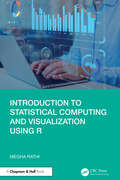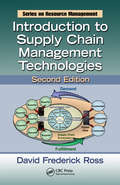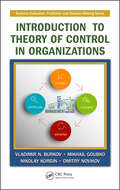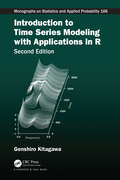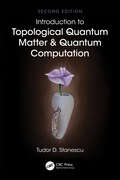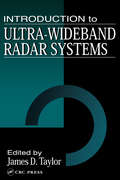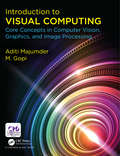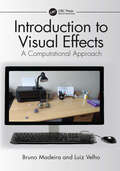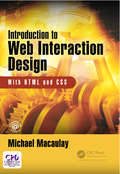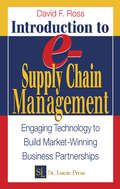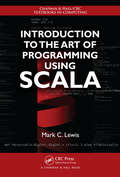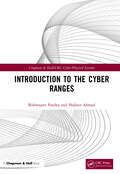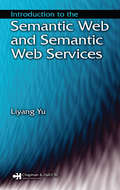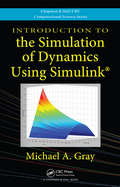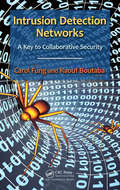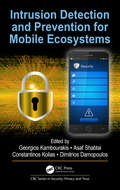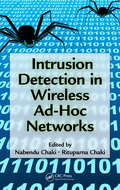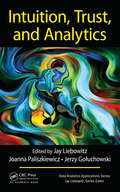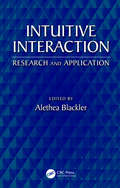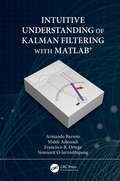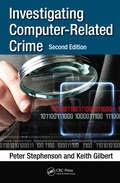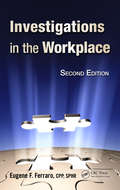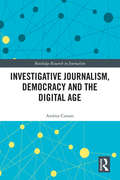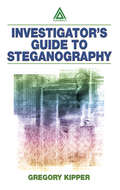- Table View
- List View
Introduction to Statistical Computing and Visualization Using R
by Megha RathiThe book provides a foundational guide to statistical computing and visualisation Using R programming with an emphasis on practical data analysis skills that are directly applicable to diverse fields like finance, defence, health, and education. It uniquely combines a thorough explanation of basic constructs with advanced topics such as data visualisation, statistical modeling, and probability, making it accessible yet comprehensive for learners across disciplines. This approach allows readers not only to build essential R skills but also to apply them to real-world scenarios, equipping students and professionals from various disciplines with versatile analytical tools. It offers a comprehensive yet approachable introduction for students and scholars from various disciplines using R. Includes practical and interactive elements such as quizzes, coding exercises, and hands-on projects can provide an engaging and effective learning experience for readers Provides complete code solutions to every problem presented, including detailed answers to even the most complex questions Presents case studies that can help contextualize the concepts covered in the book by showing how they are used in specific industries, fields, or contexts Offers application-based practical data analysis with cases in various fields and sectors, such as finance, healthcare, and marketing Focuses on best practices and efficient coding techniques, improving productivity and maintainability of R code
Introduction to Supply Chain Management Technologies (Resource Management)
by David Frederick Ross Frederick S. Weston Stephen W.It is almost impossible to conceive of the concept and practical application of supply chain management (SCM) without linking it to the enabling power of today‘s information technologies. Building upon the foundations of the first edition, Introduction to Supply Chain Management Technologies, Second Edition details the software toolsets and suites
Introduction to Theory of Control in Organizations (Systems Evaluation, Prediction, and Decision-Making)
by Vladimir N. Burkov Mikhail Goubko Nikolay Korgin Dmitry NovikovIntroduction to Theory of Control in Organizations explains how methodologies from systems analysis and control theory, including game and graph theory, can be applied to improve organizational management. The theory presented extends the traditional approach to management science by introducing the optimization and game-theoretical tools required
Introduction to Time Series Modeling with Applications in R (Chapman & Hall/CRC Monographs on Statistics and Applied Probability)
by Genshiro KitagawaPraise for the first edition: [This book] reflects the extensive experience and significant contributions of the author to non-linear and non-Gaussian modeling. … [It] is a valuable book, especially with its broad and accessible introduction of models in the state-space framework. –Statistics in Medicine What distinguishes this book from comparable introductory texts is the use of state-space modeling. Along with this come a number of valuable tools for recursive filtering and smoothing, including the Kalman filter, as well as non-Gaussian and sequential Monte Carlo filters. –MAA Reviews Introduction to Time Series Modeling with Applications in R, Second Edition covers numerous stationary and nonstationary time series models and tools for estimating and utilizing them. The goal of this book is to enable readers to build their own models to understand, predict and master time series. The second edition makes it possible for readers to reproduce examples in this book by using the freely available R package TSSS to perform computations for their own real-world time series problems. This book employs the state-space model as a generic tool for time series modeling and presents the Kalman filter, the non-Gaussian filter and the particle filter as convenient tools for recursive estimation for state-space models. Further, it also takes a unified approach based on the entropy maximization principle and employs various methods of parameter estimation and model selection, including the least squares method, the maximum likelihood method, recursive estimation for state-space models and model selection by AIC. Along with the standard stationary time series models, such as the AR and ARMA models, the book also introduces nonstationary time series models such as the locally stationary AR model, the trend model, the seasonal adjustment model, the time-varying coefficient AR model and nonlinear non-Gaussian state-space models. About the Author: Genshiro Kitagawa is a project professor at the University of Tokyo, the former Director-General of the Institute of Statistical Mathematics, and the former President of the Research Organization of Information and Systems.
Introduction to Topological Quantum Matter & Quantum Computation
by Tudor D. StanescuWhat is "topological" about topological quantum states? How many types of topological quantum phases are there? What is a zero-energy Majorana mode, how can it be realized in a solid-state system, and how can it be used as a platform for topological quantum computation? What is quantum computation and what makes it different from classical computation?Addressing these and other related questions, Introduction to Topological Quantum Matter & Quantum Computation provides an introduction to and a synthesis of a fascinating and rapidly expanding research field emerging at the crossroads of condensed matter physics, mathematics, and computer science. Providing the big picture and emphasizing two major new paradigms in condensed matter physics – quantum topology and quantum information – this book is ideal for graduate students and researchers entering this field, as it allows for the fruitful transfer of ideas amongst different areas, and includes many specific examples to help the reader understand abstract and sometimes challenging concepts. It explores the topological quantum world beyond the well-known topological insulators and superconductors and unveils the deep connections with quantum computation. It addresses key principles behind the classification of topological quantum phases and relevant mathematical concepts and discusses models of interacting and noninteracting topological systems, such as the toric code and the p-wave superconductor. The book also covers the basic properties of anyons, and aspects concerning the realization of topological states in solid state structures and cold atom systems.Topological quantum computation is also presented using a broad perspective, which includes elements of classical and quantum information theory, basic concepts in the theory of computation, such as computational models and computational complexity, examples of quantum algorithms, and key ideas underlying quantum computation with anyons. This new edition has been updated throughout, with exciting new discussions on crystalline topological phases, including higher-order topological insulators; gapless topological phases, including Weyl semimetals; periodically-driven topological insulators; and a discussion of axion electrodynamics in topological materials.Key Features:· Provides an accessible introduction to this exciting, cross-disciplinary area of research.· Fully updated throughout with new content on the latest result from the field.· Authored by an authority on the subject.Tudor Stanescu is a professor of Condensed Matter Theory at West Virginia University, USA. He received a B.S. in Physics from the University of Bucharest, Romania, in 1994 and a Ph.D. in Theoretical Physics from the University of Illinois at Urbana Champaign in 2002. He was a Postdoctoral Fellow at Rutgers University and at the University of Maryland from 2003 to 2009. He joined the Department of Physics and Astronomy at West Virginia University in Fall 2009. Prof. Stanescu’s research interests encompass a variety of topics in theoretical condensed matter physics including topological insulators and superconductors, topological quantum computation, ultra-cold atom systems in optical lattices, and strongly correlated materials, such as, for example, cuprate high-temperature superconductors. His research uses a combination of analytical and numerical tools and focuses on understanding the emergence of exotic states of matter in solid state and cold atom structures, for example, topological superconducting phases that host Majorana zero modes, and on investigating the possibilities of exploiting these states as physical platforms for quantum computation.
Introduction to Ultra-Wideband Radar Systems
by James D. TaylorThis introductory reference covers the technology and concepts of ultra-wideband (UWB) radar systems. It provides up-to-date information for those who design, evaluate, analyze, or use UWB technology for any application. Since UWB technology is a developing field, the authors have stressed theory and hardware and have presented basic principles and concepts to help guide the design of UWB systems. Introduction to Ultra-Wideband Radar Systems is a comprehensive guide to the general features of UWB technology as well as a source for more detailed information.
Introduction to Visual Computing: Core Concepts in Computer Vision, Graphics, and Image Processing
by Aditi Majumder M. GopiIntroduction to Visual Computing: Core Concepts in Computer Vision, Graphics, and Image Processing covers the fundamental concepts of visual computing. Whereas past books have treated these concepts within the context of specific fields such as computer graphics, computer vision or image processing, this book offers a unified view of these core concepts, thereby providing a unified treatment of computational and mathematical methods for creating, capturing, analyzing and manipulating visual data (e.g. 2D images, 3D models). Fundamentals covered in the book include convolution, Fourier transform, filters, geometric transformations, epipolar geometry, 3D reconstruction, color and the image synthesis pipeline. The book is organized in four parts. The first part provides an exposure to different kinds of visual data (e.g. 2D images, videos and 3D geometry) and the core mathematical techniques that are required for their processing (e.g. interpolation and linear regression.) The second part of the book on Image Based Visual Computing deals with several fundamental techniques to process 2D images (e.g. convolution, spectral analysis and feature detection) and corresponds to the low level retinal image processing that happens in the eye in the human visual system pathway. The next part of the book on Geometric Visual Computing deals with the fundamental techniques used to combine the geometric information from multiple eyes creating a 3D interpretation of the object and world around us (e.g. transformations, projective and epipolar geometry, and 3D reconstruction). This corresponds to the higher level processing that happens in the brain combining information from both the eyes thereby helping us to navigate through the 3D world around us. The last two parts of the book cover Radiometric Visual Computing and Visual Content Synthesis. These parts focus on the fundamental techniques for processing information arising from the interaction of light with objects around us, as well as the fundamentals of creating virtual computer generated worlds that mimic all the processing presented in the prior sections. The book is written for a 16 week long semester course and can be used for both undergraduate and graduate teaching, as well as a reference for professionals.
Introduction to Visual Effects: A Computational Approach
by Luiz Velho Bruno MadeiraIntroduction to Visual Effects: A Computational Approach is the first single introduction to the computational and mathematical aspects of visual effects, incorporating both computer vision and graphics. The book also provides the readers with the source code to a library, enabling them to follow the chapters directly and build up a complete visual effects platform. The book covers the basic approaches to camera pose estimation, global illumination, and image-based lighting, and includes chapters on the virtual camera, optimization and computer vision, path tracing and many more. Key features include: Introduction to projective geometry, image-based lighting (IBL), global illumination solved by the Monte Carlo method (Pathtracing), an explanation of a set of optimization methods, and the techniques used for calibrating one, two, and many cameras, including how to use the RANSAC algorithm in order to make the process robust, and providing code to be implemented using the Gnu Scientific Library. C/C++ code using the OpenCV library, to be used in the process of tracking points on a movie (an important step for the matchmove process), and in the construction of modeling tools for visual effects. A simple model of the Bidirectional Reflectance Distribution Function (BRDF) of surfaces and the differential rendering method, allowing the reader to generate consistent shadows, supported by a code that can be used in combination with a software like Luminance HDR.
Introduction to Wavelet Transforms
by Nirdosh BhatnagarThe textbook, Introduction to Wavelet Transforms provides basics of wavelet transforms in a self-contained manner. Applications of wavelet transform theory permeate our daily lives. Therefore it is imperative to have a strong foundation for this subject. Features No prior knowledge of the subject is assumed. Sufficient mathematical background is provided to complete the discussion of different topics. Different topics have been properly segmented for easy learning. This makes the textbook pedagogical and unique. Notation is generally introduced in the definitions. Relatively easy consequences of the definitions are listed as observations, and important results are stated as theorems. Examples are provided for clarity and to enhance reader's understanding of the subject. Each chapter also has a problem section. A majority of the problems are provided with sufficient hints. The textbook can be used either in an upper-level undergraduate or first-year graduate class in electrical engineering, or computer science, or applied mathematics. It can also be used by professionals and researchers in the field who would like a quick review of the basics of the subject. About the Author: Nirdosh Bhatnagar works in both academia and industry in Silicon Valley, California. He is also the author of a comprehensive two-volume work: Mathematical Principles of the Internet, published by the CRC Press in the year 2019. Nirdosh earned M.S. in Operations Research, and M.S. and Ph.D. in electrical engineering, all from Stanford University, Stanford, California..
Introduction to Web Interaction Design: With HTML and CSS
by Michael MacaulayThis book introduces standard and new HTML5 elements and attributes and CSS3 properties commonly used in Web design as well as design guidelines for their effective use. Its approach of explaining every line of code in the examples it uses to show the usage of the HTML elements and CSS properties introduced makes it an invaluable Web design resource for beginners as well as intermediates looking to fill in gaps in their knowledge. In addition, the inclusion of user-centered design process stages and how they are best managed in website development makes the book unique in its area. Also, the book's approach of including challenges after each topic to help refresh readers' knowledge, as well as make them think, ensures that there are ample activities to keep learners motivated and engaged. Michael Macaulay is a freelance educator, developer, and user-experience designer and evaluator. Formerly, he was a senior lecturer and course director for multimedia courses at London South Bank University, United Kingdom. He earned his PhD in 2000 in the effects of human–computer interaction and multimedia in learning from Loughborough University, United Kingdom. In the past, he had also been a computer systems administrator, computer systems programmer and analyst, and desktop publisher. ????
Introduction to e-Supply Chain Management: Engaging Technology to Build Market-Winning Business Partnerships (Resource Management)
by David Frederick RossIn the quest to remove supply channel costs, streamline channel communications, and link customers to the value-added resources found along the supply chain continuum, Supply Chain Management (SCM) has emerged as a tactical operations tool. The first book to completely define the architecture of the merger of SCM and the Internet, Introduction to e
Introduction to the Art of Programming Using Scala (Chapman And Hall/crc Textbooks In Computing Ser.)
by Mark C. LewisWith its flexibility for programming both small and large projects, Scala is an ideal language for teaching beginning programming. Yet there are no textbooks on Scala currently available for the CS1/CS2 levels. Introduction to the Art of Programming Using Scala presents many concepts from CS1 and CS2 using a modern, JVM-based language that works we
Introduction to the Cyber Ranges (Chapman & Hall/CRC Cyber-Physical Systems)
by Bishwajeet Pandey Shabeer AhmadIntroduction to the Cyber Ranges provides a comprehensive, integrative, easy-to-comprehend overview of different aspects involved in the cybersecurity arena. It expands on various concepts like cyber situational awareness, simulation and emulation environments, and cybersecurity exercises. It also focuses on detailed analysis and the comparison of various existing cyber ranges in military, academic, and commercial sectors. It highlights every crucial aspect necessary for developing a deeper insight about the working of the cyber ranges, their architectural design, and their need in the market. It conveys how cyber ranges are complex and effective tools in dealing with advanced cyber threats and attacks. Enhancing the network defenses, resilience, and efficiency of different components of critical infrastructures is the principal objective of cyber ranges. Cyber ranges provide simulations of possible cyberattacks and training on how to thwart such attacks. They are widely used in urban enterprise sectors because they present a sturdy and secure setting for hands-on cyber skills training, advanced cybersecurity education, security testing/training, and certification. Features: A comprehensive guide to understanding the complexities involved with cyber ranges and other cybersecurity aspects Substantial theoretical knowhow on cyber ranges, their architectural design, along with case studies of existing cyber ranges in leading urban sectors like military, academic, and commercial Elucidates the defensive technologies used by various cyber ranges in enhancing the security setups of private and government organizations Information organized in an accessible format for students (in engineering, computer science, and information management), professionals, researchers, and scientists working in the fields of IT, cybersecurity, distributed systems, and computer networks
Introduction to the Semantic Web and Semantic Web Services
by Liyang YuEven though the semantic Web is a relatively new and dynamic area of research, a whole suite of components, standards, and tools have already been developed around it. Using a concrete approach, Introduction to the Semantic Web and Semantic Web Services builds a firm foundation in the concept of the semantic Web, its principal technologies, its rea
Introduction to the Simulation of Dynamics Using Simulink (Chapman & Hall/CRC Computational Science)
by Michael A. GrayDesigned for undergraduate students in the general science, engineering, and mathematics community, Introduction to the Simulation of Dynamics Using Simulink (R) shows how to use the powerful tool of Simulink to investigate and form intuitions about the behavior of dynamical systems. Requiring no prior programming experience, it clearly explains how to transition from physical models described by mathematical equations directly to executable Simulink simulations.Teaches students how to model and explore the dynamics of systemsStep by step, the author presents the basics of building a simulation in Simulink. He begins with finite difference equations and simple discrete models, such as annual population models, to introduce the concept of state. The text then covers ordinary differential equations, numerical integration algorithms, and time-step simulation. The final chapter offers overviews of some advanced topics, including the simulation of chaotic dynamics and partial differential equations.A one-semester undergraduate course on simulationWritten in an informal, accessible style, this guide includes many diagrams and graphics as well as exercises embedded within the text. It also draws on numerous examples from the science, engineering, and technology fields. The book deepens students' understanding of simulated systems and prepares them for advanced and specialized studies in simulation.
Intrusion Detection Networks: A Key to Collaborative Security
by Raouf Boutaba Carol FungThe rapidly increasing sophistication of cyber intrusions makes them nearly impossible to detect without the use of a collaborative intrusion detection network (IDN). Using overlay networks that allow an intrusion detection system (IDS) to exchange information, IDNs can dramatically improve your overall intrusion detection accuracy.Intrusion Detect
Intrusion Detection and Prevention for Mobile Ecosystems (Series in Security, Privacy and Trust)
by Georgios Kambourakis, Asaf Shabtai, Constantinos Kolias and Dimitrios DamopoulosThis book presents state-of-the-art contributions from both scientists and practitioners working in intrusion detection and prevention for mobile networks, services, and devices. It covers fundamental theory, techniques, applications, as well as practical experiences concerning intrusion detection and prevention for the mobile ecosystem. It also includes surveys, simulations, practical results and case studies.
Intrusion Detection in Wireless Ad-Hoc Networks
by Nabendu Chaki Rituparna ChakiPresenting cutting-edge research, Intrusion Detection in Wireless Ad-Hoc Networks explores the security aspects of the basic categories of wireless ad-hoc networks and related application areas. Focusing on intrusion detection systems (IDSs), it explains how to establish security solutions for the range of wireless networks, including mobile ad-hoc
Intuition, Trust, and Analytics (Data Analytics Applications)
by Jerzy Gołuchowski Joanna Paliszkiewicz Jay LiebowitzIn order to make informed decisions, there are three important elements: intuition, trust, and analytics. Intuition is based on experiential learning and recent research has shown that those who rely on their “gut feelings” may do better than those who don’t. Analytics, however, are important in a data-driven environment to also inform decision making. The third element, trust, is critical for knowledge sharing to take place. These three elements—intuition, analytics, and trust—make a perfect combination for decision making. This book gathers leading researchers who explore the role of these three elements in the process of decision-making.
Intuitive Interaction: Research and Application
by Alethea BlacklerThis book explores recent research in intuitive interaction worldwide by a range of leading academics and practitioners in the field. It builds on past work as it ventures into new areas, such as how users perceive intuitiveness of an interface, how people experience intuitive interaction subjectively, and how we can use such understanding to design more engaging experiences. The book addresses how intuitive interaction is understood in different academic disciplines and how it has been researched in various parts of the world over the last 18 years. It covers how intuitive interaction can be applied in different contexts, like large scale urban installations, the developing world, in older populations, and in various industry applications. <P><P>Features: <li>Presents varied approaches to intuitive interaction research and application <li>Illustrates how to understand and apply intuitive interaction to interfaces <li>Provides a mix of academic and industry perspectives <li>Explores a variety of contexts for application of intuitive interaction <li>Encompasses design, IT, business, and psychological approaches
Intuitive Understanding of Kalman Filtering with MATLAB®
by Francisco R. Ortega Armando Barreto Malek Adjouadi Nonnarit O-larnnithipongThe emergence of affordable micro sensors, such as MEMS Inertial Measurement Systems, are applied in embedded systems and Internet-of-Things devices. This has brought techniques such as Kalman Filtering, which are capable of combining information from multiple sensors or sources, to the interest of students and hobbyists. This book will explore the necessary background concepts, helping a much wider audience of readers develop an understanding and intuition that will enable them to follow the explanation for the Kalman Filtering algorithm. Key Features: Provides intuitive understanding of Kalman Filtering approach Succinct overview of concepts to enhance accessibility and appeal to a wide audience Interactive learning techniques with code examples Malek Adjouadi, PhD, is Ware Professor with the Department of Electrical and Computer Engineering at Florida International University, Miami. He received his PhD from the Electrical Engineering Department at the University of Florida, Gainesville. He is the Founding Director of the Center for Advanced Technology and Education funded by the National Science Foundation. His earlier work on computer vision to help persons with blindness led to his testimony to the U.S. Senate on the committee of Veterans Affairs on the subject of technology to help persons with disabilities. His research interests are in imaging, signal processing and machine learning, with applications in brain research and assistive technology. Armando Barreto, PhD, is Professor of the Electrical and Computer Engineering Department at Florida International University, Miami, as well as the Director of FIU’s Digital Signal Processing Laboratory, with more than 25 years of experience teaching DSP to undergraduate and graduate students. He earned his PhD in electrical engineering from the University of Florida, Gainesville. His work has focused on applying DSP techniques to the facilitation of human-computer interactions, particularly for the benefit of individuals with disabilities. He has developed human-computer interfaces based on the processing of signals and has developed a system that adds spatialized sounds to the icons in a computer interface to facilitate access by individuals with "low vision." With his research team, he has explored the use of Magnetic, Angular-Rate and Gravity (MARG) sensor modules and Inertial Measurement Units (IMUs) for human-computer interaction applications. He is a senior member of the Institute of Electrical and Electronics Engineers (IEEE) and the Association for Computing Machinery (ACM). Francisco R. Ortega, PhD, is an Assistant Professor at Colorado State University and Director of the Natural User Interaction Lab (NUILAB). Dr. Ortega earned his PhD in Computer Science (CS) in the field of Human-Computer Interaction (HCI) and 3D User Interfaces (3DUI) from Florida International University (FIU). He also held a position of Post-Doc and Visiting Assistant Professor at FIU. His main research area focuses on improving user interaction in 3DUI by (a) eliciting (hand and full-body) gesture and multimodal interactions, (b) developing techniques for multimodal interaction, and (c) developing interactive multimodal recognition systems. His secondary research aims to discover how to increase interest for CS in non-CS entry-level college students via virtual and augmented reality games. His research has resulted in multiple peer-reviewed publications in venues such as ACM ISS, ACM SUI, and IEEE 3DUI, among others. He is the first-author of the CRC Press book Interaction Design for 3D User Interfaces: The World of Modern Input Devices for Research, Applications and Game Development. Nonnarit O-larnnithipong, PhD, is an Instructor at Florida International University. Dr. O-larnnithipong earned his PhD in Electrical Engineering, majoring in Digital Signal Processing from Florida International Unive
Investigating Computer-Related Crime
by Peter Stephenson Keith GilbertSince the last edition of this book was written more than a decade ago, cybercrime has evolved. Motives have not changed, but new means and opportunities have arisen with the advancement of the digital age. Investigating Computer-Related Crime: Second Edition incorporates the results of research and practice in a variety of venues, growth in the fi
Investigations in the Workplace
by Eugene F. Ferraro Ban Seng Choo T.J. MacGinleyThe process of investigation is dynamic and fluid. The approach must be reasonable and the investigator flexible. However, in order to be successful, every investigation must have a meaningful purpose and be executed ethically and lawfully.Inevitably, employers must invest time, money, and patience to ensure they obtain demonstrable and actionable
Investigative Journalism, Democracy and the Digital Age (Routledge Research in Journalism)
by Andrea CarsonTheoretically grounded and using quantitative data spanning more than 50 years together with qualitative research, this book examines investigative journalism’s role in liberal democracies in the past and in the digital age. In its ideal form, investigative reporting provides a check on power in society and therefore can strengthen democratic accountability. The capacity is important to address now because the political and economic environment for journalism has changed substantially in recent decades. In particular, the commercialization of the Internet has disrupted the business model of traditional media outlets and the ways news content is gathered and disseminated. Despite these disruptions, this book’s central aim is to demonstrate using empirical research that investigative journalism is not in fact in decline in developed economies, as is often feared.
Investigator's Guide to Steganography
by Gregory KipperThe Investigator's Guide to Steganography provides a comprehensive look at this unique form of hidden communication from its beginnings to modern uses. It begins by exploring the past; providing insight into how this steganography began and evolved from ancient times to present day. It continues with an in-depth look at the workings of digital steganography and watermarking methods, available tools on the Internet, and the companies who are providing cutting edge steganography and watermarking services. The third section outlines real world uses of steganography. The book concludes by reviewing steganography detection methods and what can be expected in the future.
